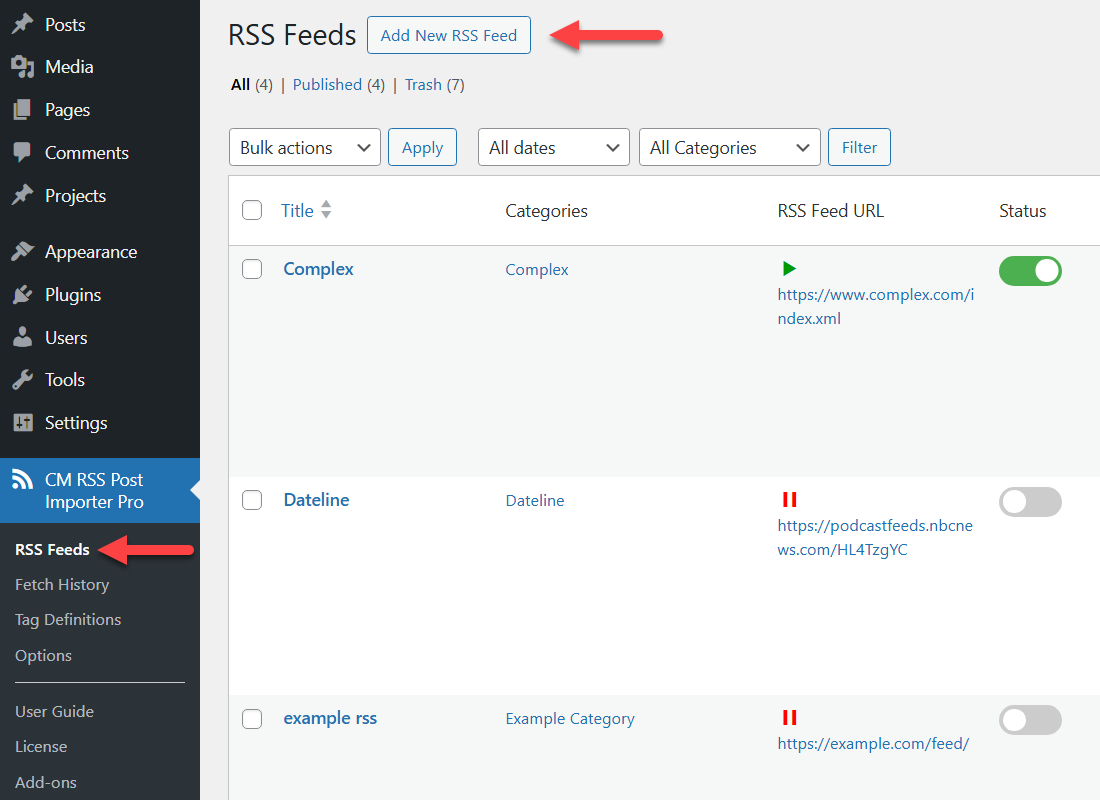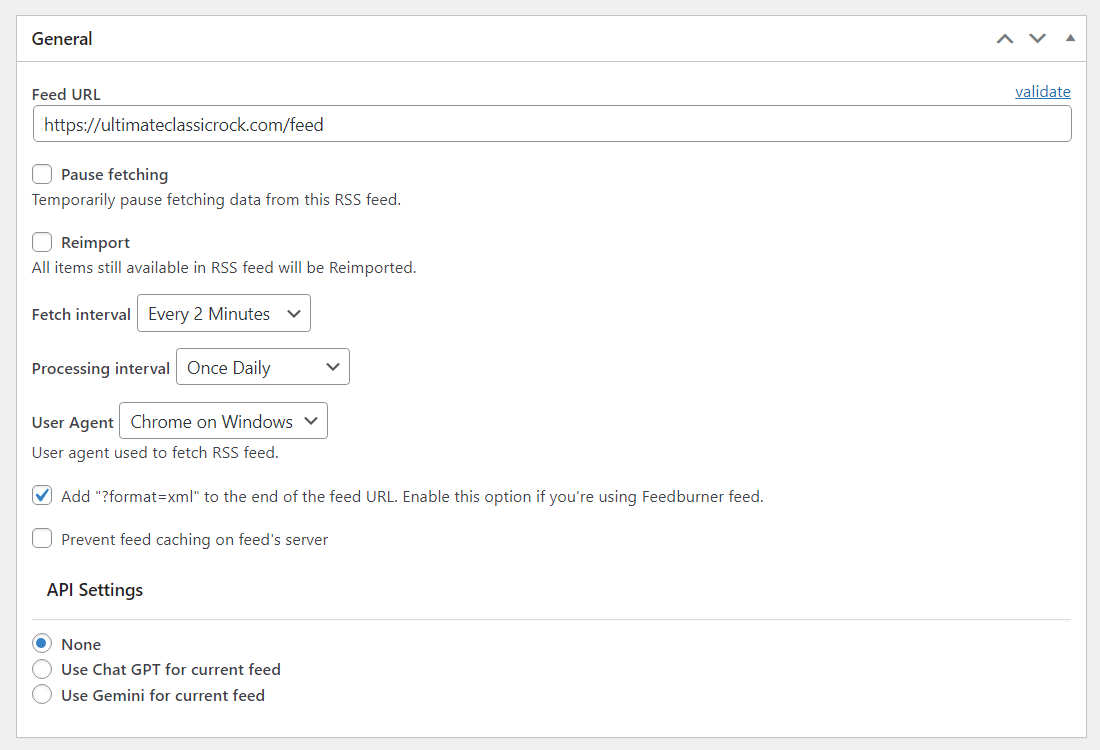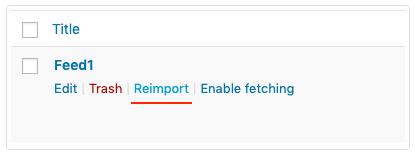RSS Post Importer - Set Up - 1) Adding a Feed
Step 1 - Adding a Feed
Video version
Video Tutorial - Getting Started With RSS Post Importer
Step by step
- Adding The Feed.
- Choosing How The Plugin Will Handle The Feed. Involves keywords that will be excluded, date limit, and more.
- Choosing How The Plugin Will Handle Each Post. Involves word limit and HTML removal.
- Choosing Where and How Will The Feeds Be Posted. Involves post status, tags, categories, featured image, excerpt, author and more.
TIP: Copy Existing Feed
You can also save time and copy an existing feed to edit it! Learn more: RSS Post Importer - Duplicating a Feed.
To begin adding a feed using RSS Post Importer, head to WP Admin → CM RSS Importer Pro → RSS Feeds. Then, click the button Add New RSS Feed.

The General settings allow the Feed to begin importing and offer some blunt controls for the overall importing of the feed , before the nitty-gritty settings that follow.

- Feed URL - The source URL of the feed (e.g. http://example.com/music/charts/topfourty.rss). Make sure the source you are trying to import is a valid RSS feed. You can check this by using the "validate" link. Also, please visit our troubleshooting guide as some sites block importing posts from their site.
- Validate - Click on this link to check if the feed is valid.
- Pause Fetching - Check this box to temporarily disable the RSS Post Importer plugin from importing any more posts from this RSS Feed.
Reimport - Apply this option if you change some settings that determine how feeds are imported (steps 2, 3 or 4). This setting allows the RSS feed to be reimported according to the new settings. Once you click the "Update" button, there will be a red-colored notification that the reimport is done.
Note that the feeds will NOT be reimported right away. This option ensures that any new rules will be applied during the next import.
It works the same as clicking Reimport on the feed management screen:

- Fetch interval - How often the plugin will run and import any new RSS content added. If you set this number to run frequently this may slow your site depending on the number of posts available on the source site. Make sure you understand the impact of the frequency on your site's performance. Note: up to version 1.5.5 this option was called Processing interval, and starting from version 1.5.6 it was renamed to Fetch interval.
Processing interval - How often RSS feeds will be converted to WP posts. If you set this number to run frequently this may slow your site depending on the number of posts available on the source site. Make sure you understand the impact of the frequency on your site's performance. Note: this option was introduced in version 1.5.6.
TIP: Creating New Values
You can create new options, such as "Every two days" for the options Fetch interval and Processing interval. Learn more: RSS Post Importer - Advanced - Creating Processing Intervals With WP Crontrol
- User Agent - Allows control over the User-Agent signature applied to the RSS request. This can be a useful way to bypass RSS request blocks to certain devices. This setting just overwrites the generic setting for all feeds.
- Add "?format=xml" to the end of the feed URL - Check this if you are using a FeedBurner feed to ensure compatibility.
- Prevent feed caching on feed's server - Enable this on the rare cases when the feed is cached on the feed's server for some reason. When that is the case, the feed might result in the same result for days.
- API Settings - This option allows to enable override global plugin settings for additional tools. The options are:
- None
- Use ChatGPT for current feed - Learn more about it below.
Use Gemini for current feed - Learn more about it below.
Note: this option was introduced in version 1.7.1.
Use Chat GPT for current feed
Note: ChatGPT settings were introduced in version 1.7.0.
This section allows to enable and override global plugin settings for the ChatGPT integration. The options are:

- Use Chat GPT for current feed - Check the box to enable the ChatGPT feature for the current RSS feed. By default, it's disabled.
- Chat GPT AI Role - Here you can define the role for the Chat GPT assistant to make your content more specialized. This way, if you define the assistant as an expert in some certain area, it will generate the content related to your main topic.
- Chat GPT Reply Length - Set the maximum length of the reply requested from the ChatGPT. This value is set in tokens. Warning: longer replies use more tokens, so you can reach limit faster. Learn more about Pricing Plans.
- Chat GPT Temperature - This option allows to define how accurate the generated content will be. This value ranges from 0 to 2. Higher values like 0.8 will make the output more random, while lower values like 0.2 will make it more focused and deterministic.
- Disable rewriting the title with Chat GPT - Turn on this option if you want to keep the original article title provided by the source feed. Note: this option was introduced in version 1.7.1.
- Chat GPT Prompt title template - Specify the request which the plugin will be sending to ChatGPT for generating new title for the article. Important: this template must contain the following placeholder: {rss_title}.
- Chat GPT Prompt content template - Specify the request which the plugin will be sending to ChatGPT for generating new content for the article. Important: this template must contain the following placeholder: {rss_content}.
Note: If any of these fields is empty, then it follows the global plugin settings.
Learn more about the ChatGPT integration in this use case guide:
Use Gemini for current feed
Note: Gemini settings were introduced in version 1.7.1.
This section allows to enable and override global plugin settings for the Gemini integration. The options are:

- Use Gemini for current feed - Check the box to enable the Gemini feature for the current RSS feed. By default, it's disabled.
- Gemini Reply Length - Set the maximum length of the reply requested from the Gemini. This value is set in tokens. Have a note that Gemini Pro replies are limited by 2048 tokens, while Gemini Pro 1.5 can be unlimited.
- Gemini Temperature - This option allows to define how accurate the generated forum answer will be. This value ranges from 0 to 2. Lower temperatures are good for prompts that require a more deterministic and less open-ended or creative response, while higher temperatures can lead to more diverse or creative results.
- Gemini Safety Level - The Gemini API blocks content based on the probability of content being unsafe. By default, safety settings block content (including prompts) with medium or higher probability of being unsafe across any dimension. You can change safety level to the one is appropriate for your use case:
- Use global settings
- Always show regardless of probability of being harmful
- Block low, medium or high probability of being harmful
- Block medium or high probability of being harmful
- Block high probability of being harmful
- Disable rewriting the title with Gemini - Turn on this option if you want to keep the original article title provided by the source feed.
- Gemini Prompt title template - Specify the request which the plugin will be sending to Gemini for generating new title for the article. Important: this template must contain the following placeholder: {rss_title}.
- Gemini Prompt content template - Specify the request which the plugin will be sending to Gemini for generating new content for the article. Important: this template must contain the following placeholder: {rss_content}.
Note: If any of these fields is empty, then it follows the global plugin settings.
Learn more about the Gemini integration in this use case guide:
Step by step
- Adding The Feed.
- Choosing How The Plugin Will Handle The Feed. Involves keywords that will be excluded, date limit, and more.
- Choosing How The Plugin Will Handle Each Post. Involves word limit and HTML removal.
- Choosing Where and How Will The Feeds Be Posted. Involves post status, tags, categories, featured image, excerpt, author and more.
 |
More information about the RSS Post Importer plugin for WordPress Other WordPress products can be found at CreativeMinds WordPress Store |
 |
Let us know how we can Improve this Product Documentation Page To open a Support Ticket visit our support center |
